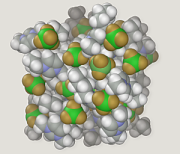Molecular modeling on GPUs

Molecular modeling on GPU is the technique of using a graphics processing unit (GPU) for molecular simulations.[1]
In 2007, NVIDIA introduced video cards that could be used not only to show graphics but also for scientific calculations. These cards include many arithmetic units (as of 2016[update], up to 3,584 in Tesla P100) working in parallel. Long before this event, the computational power of video cards was purely used to accelerate graphics calculations. What was new is that NVIDIA made it possible to develop parallel programs in a high-level application programming interface (API) named CUDA. This technology substantially simplified programming by enabling programs to be written in C/C++. More recently, OpenCL allows cross-platform GPU acceleration.
Quantum chemistry calculations[2][3][4][5][6] and molecular mechanics simulations[7][8][9] (molecular modeling in terms of classical mechanics) are among beneficial applications of this technology. The video cards can accelerate the calculations tens of times, so a PC with such a card has the power similar to that of a cluster of workstations based on common processors.
GPU accelerated molecular modelling software
Programs
- Abalone – Molecular Dynamics (Benchmark)
- AMBER on GPUs version
- Ascalaph on GPUs version – Ascalaph Liquid GPU
- BigDFT Ab initio program based on wavelet
- Blaze ligand-based virtual screening
- Desmond (software) on GPUs, workstations, and clusters
- Firefly (formerly PC GAMESS)
- FastROCS
- GOMC – GPU Optimized Monte Carlo simulation engine
- GPIUTMD – Graphical processors for Many-Particle Dynamics
- GROMACS on GPUs version
- HALMD – Highly Accelerated Large-scale MD package
- HOOMD-blue – Highly Optimized Object-oriented Many-particle Dynamics—Blue Edition
- LAMMPS on GPUs version – lammps for accelerators
- LIO DFT-Based GPU optimized code - [1]
- Octopus has support for OpenCL.
- oxDNA – DNA and RNA coarse-grained simulations on GPUs
- PWmat – Plane-Wave Density Functional Theory simulations
- TeraChem – Quantum chemistry and ab initio Molecular Dynamics
- TINKER on GPUs.[10]
- VMD & NAMD on GPUs versions
- YASARA runs MD simulations on all GPUs using OpenCL.
API
- OpenMM – an API for accelerating molecular dynamics on GPUs, v1.0 provides GPU-accelerated version of GROMACS
- mdcore – an Open-source platform-independent library for molecular dynamics simulations on modern shared-memory parallel architectures.
Distributed computing projects
- GPUGRID distributed supercomputing infrastructure
- Folding@home distributed computing project
See also
References
- ^ John E. Stone, James C. Phillips, Peter L. Freddolino, David J. Hardy 1, Leonardo G. Trabuco, Klaus Schulten (2007). "Accelerating molecular modeling applications with graphics processors". Journal of Computational Chemistry. 28 (16): 2618–2640. doi:10.1002/jcc.20829. PMID 17894371.
{{cite journal}}: CS1 maint: multiple names: authors list (link) CS1 maint: numeric names: authors list (link) - ^ Koji Yasuda (2008). "Accelerating Density Functional Calculations with Graphics Processing Unit". J. Chem. Theory Comput. 4 (8): 1230–1236. doi:10.1021/ct8001046.
- ^ Koji Yasuda (2008). "Two-electron integral evaluation on the graphics processor unit". Journal of Computational Chemistry. 29 (3): 334–342. doi:10.1002/jcc.20779. PMID 17614340.
- ^ Leslie Vogt; Roberto Olivares-Amaya; Sean Kermes; Yihan Shao; Carlos Amador-Bedolla; Alán Aspuru-Guzik (2008). "Accelerating Resolution-of-the-Identity Second-Order Møller−Plesset Quantum Chemistry Calculations with Graphical Processing Units". J. Phys. Chem. A. 112 (10): 2049–2057. doi:10.1021/jp0776762. PMID 18229900.
- ^ Ivan S. Ufimtsev; Todd J. Martinez (2008). "Quantum Chemistry on Graphical Processing Units. 1. Strategies for Two-Electron Integral Evaluation". J. Chem. Theo. Comp. 4 (2): 222–231. doi:10.1021/ct700268q.
{{cite journal}}: Unknown parameter|lastauthoramp=ignored (|name-list-style=suggested) (help) - ^ Ivan S. Ufimtsev; Todd J. Martinez (2008). "Graphical Processing Units for Quantum Chemistry". Comp. Sci. Eng. 10 (6): 26–34. doi:10.1109/MCSE.2008.148.
{{cite journal}}: Unknown parameter|lastauthoramp=ignored (|name-list-style=suggested) (help) - ^ Joshua A. Anderson; Chris D. Lorenz; A. Travesset (2008). "General Purpose Molecular Dynamics Simulations Fully Implemented on Graphics Processing Units". Journal of Computational Physics. 227 (10): 5342–5359. Bibcode:2008JCoPh.227.5342A. doi:10.1016/j.jcp.2008.01.047.
- ^ Christopher I. Rodrigues; David J. Hardy; John E. Stone; Klaus Schulten; Wen-Mei W. Hwu. (2008). "GPU acceleration of cutoff pair potentials for molecular modeling applications". In CF'08: Proceedings of the 2008 conference on Computing frontiers, New York, NY, USA: 273–282.
{{cite journal}}: Unknown parameter|last-author-amp=ignored (|name-list-style=suggested) (help) - ^ Peter H. Colberg; Felix Höfling (2011). "Highly accelerated simulations of glassy dynamics using GPUs: Caveats on limited floating-point precision". Comp. Phys. Comm. 182 (5): 1120–1129. arXiv:0912.3824. Bibcode:2011CoPhC.182.1120C. doi:10.1016/j.cpc.2011.01.009.
- ^ M. Harger, D. Li, Z. Wang, K. Dalby, L. Lagardère, J.-P. Piquemal, J. Ponder, P. Ren (2017). "Tinker-OpenMM: Absolute and relative alchemical free energies using AMOEBA on GPUs". Journal of Computational Chemistry. doi:10.1002/jcc.24853.
{{cite journal}}: CS1 maint: multiple names: authors list (link)
